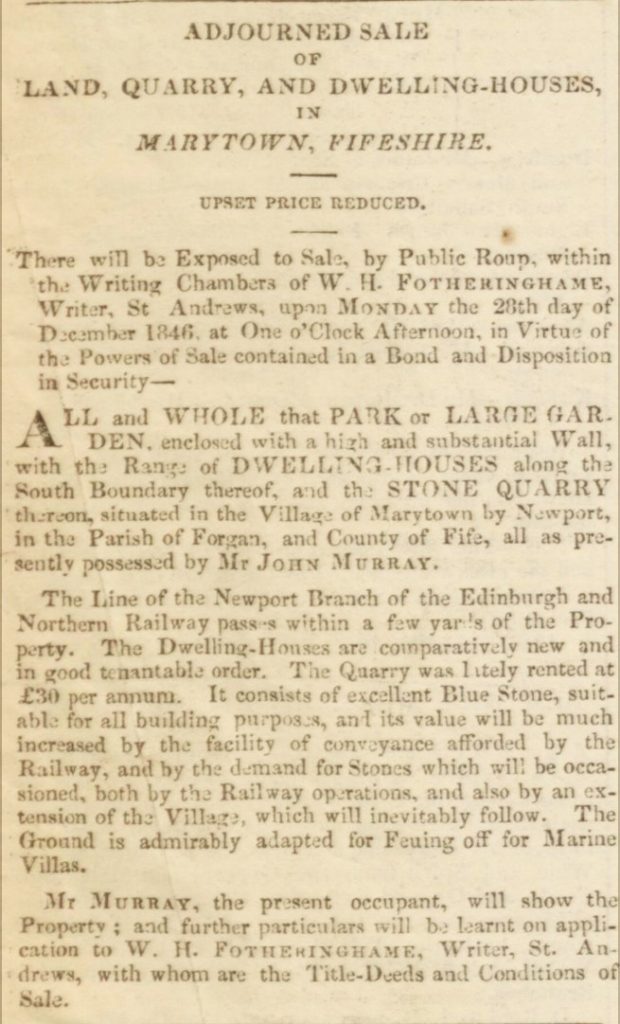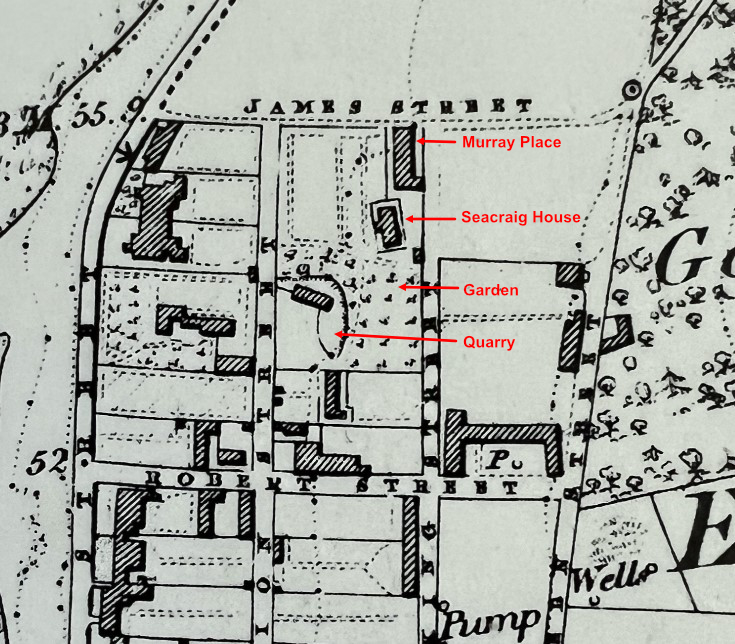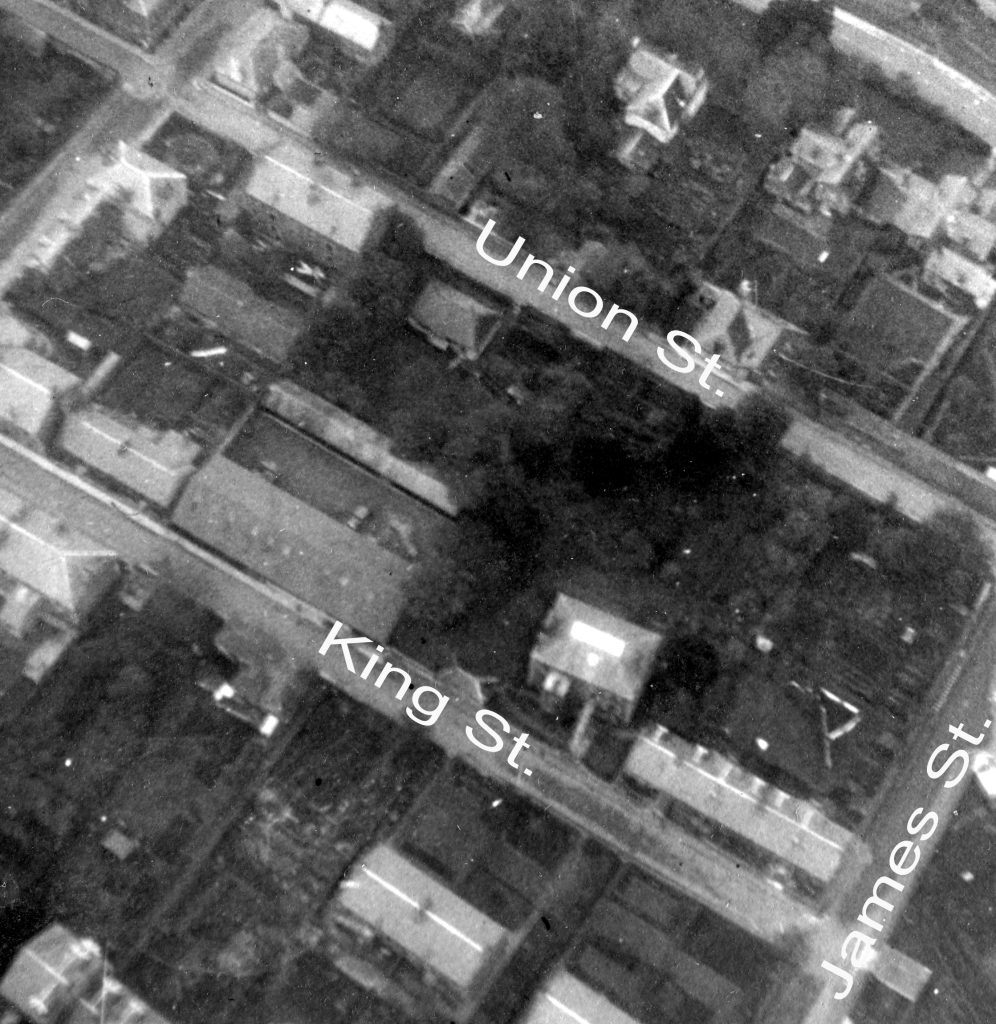In the 1820s Marytown* (the area between William Street and James Street, Tay street and Queen Street) was created on a green field site. A steam ferry to Dundee had recently been introduced and the area was seen as being ripe for development. Of the first 10 feuars, 5 were in the building trade1 and one of the first was John Murray, a mason from Sutherland (although when he took on the ground he described himself as a mere labourer).2
Murray feued a block of 5 lots of ground between Union Street and King Street, and extending from James Street three-quarters of the way to Robert Street – that was a large piece of land. But its shape allowed part of it to be used as a quarry – ideal for a mason. The quarry face is still there, behind 50 Union Street. Murray built 5 houses along the King Street boundary, opened up the quarry, and established a walled garden for fruit and vegetables. He called the houses ‘Murray Place’.3

Advertising the property to let in 1837, the houses take pride of place – one is suitable for a genteel family, then the garden, and last the quarry. In another advert in 1842 the houses were ‘well adapted for summer lodgings’.4
Business must have had its ups and downs. Murray was able to rent out the quarry, and the houses would have easily found tenants. But in 1846 he defaulted on a loan secured over the property5, which meant he lost it all.

Notice this time the ground and garden are placed first, the houses second and the quarry last. The land could be feued off to provide ‘marine villas’. Property adverts need to be taken with a pinch of salt – the railway line was only a proposed line; and the comparatively new houses were at least 15 years old.
Eventually the whole site was acquired by Alexander Rhind, corn merchant and tenant of Woodhaven Farm.6 About the same time, Rhind feued the site at the other end of King Street on the corner with Gowrie Street. On the Gowrie Street site he built a bakehouse and shop, while on the Seacraig site he built Seacraig House.7 Rhind moved into Seacraig House himself and Murray rented one of his original houses.8

Over time, Seacraig House was home to Harry Walker, Dundee jute merchant (Dura Works & Caldrum Works), who lived here before Westwood (now St Serfs) was built; then retired sea captain Robert Brown.9 Eventually it was turned into flats about 1914, and demolished in 1956.10 It is now the site of Seacraig Court.

The Murray Place houses were later called Seacraig Cottages. They too made way for Seacraig Court. (The whole site between King Street and Union Street had actually been identified as a possible site for housing by Newport Town Council in 1919.)11
The productive walled garden in 1869 became the first home of Newport Bowling Club. They moved to Scott Street in 1877 and the green here was then used by the Maryton Bowling Club. From 1925 it was the site of Seacraig Garage, and now of the houses 31-37 King Street.12
The quarry had stores and stables on it and the bungalow was built in the 1920s.13
Seacraig Court was opened for new residents in 1958.14

* Marytown in Newport is frequently spelled Maryton, and is not to be confused with Maryton, a parish near Montrose, which is sometimes spelled Marytown. Searches for either must include both spellings.
Sources
(Look on this as an example of what can be gained from documentary sources; links to the Archive pages have further reference details there):
- Sasine Abridgements, Fife, originals at National Records of Scotland
- Sasine Abridgements, Fife 1826 03206; Census 1841 Forgan parish, Fife, District 1, p 12; Census 1851, Forgan parish, Fife, District 1, p 13, originals at ScotlandsPeople
- Registers of Voters, Fife, 1832
- Fife Herald, 28 Apr 1842, p1
- Fife Herald, 10 Dec 1846, p1; Sasine Abridgements, Fife, Marytown, plot of 5 pieces of ground
- Sasine Abridgements; Fifeshire Journal, 19 Feb 1846, p1
- Dundee Courier, 21 Nov 1911, p6 – obituary of H S Rhind
- Census 1851, Forgan parish, Fife, District 1, p 13
- Directory and Valuation Roll entries for Seacraig House
- Minutes of Newport Town Council, 1956
- Minutes of Newport Town Council, 1919
- Directory and Valuation Roll entries for Marytown Bowling Green; and Seacraig Garage
- Valuation Roll entries for quarry site
- Fife, Scotland, Electoral Registers, 1914-1966, available on ancestry.co.uk
Photos:
- Fife Herald, 21 Sep 1837, p1 (all newspapers available at British Newspaper Archive)
- Fife Herald, 10 Dec 1846, p1
- Ordnance Survey 6″ Fife, 1854, copy at National Library of Scotland, Map Images
- Seacraig 1943, reproduced here with thanks to the owner, Gerd Garnes
- Google StreetView, 56.4425199,-2.9382257, May 2009
